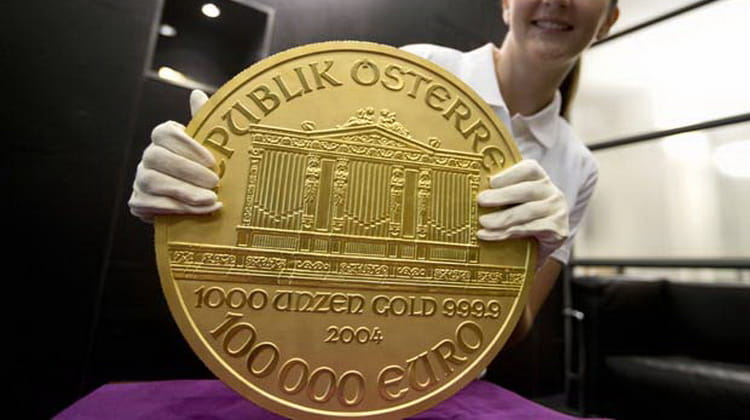
Gold and silver euros of Austria started to be minted in 2002, as soon as the euro was introduced into circulation on the territory of the country. The Austrian mint uses silver with a fineness of 800, 900, 925 and 999.9 for silver euro coins mintage. Gold euros are minted from gold with a fineness of 986 and 999.9. All coins from precious metals can be divided into commemorative, collectible and investment, although each one can serve as a means of saving and enrich a numismatic collection.
Series of silver euros
A nominal value of 10 euro (fineness of 925)
Austria and her people (Castles of Austria)
Ambras Castle (4.24.2002):
- Weight: 17.3 g
- Diameter: 32 mm
- Obverse: facade of the castle «Schloss Ambras»; inscription «REPUBLIK ÖSTERREICH» at the top; denomination, the name of the castle and year of minting at the bottom.
- Reverse: three musicians dancing in the “Spanish Hall” of the castle.
- Circulation: 130,000
Austrian 10 Euro 2002 silver coins in GoldAdvert catalog.
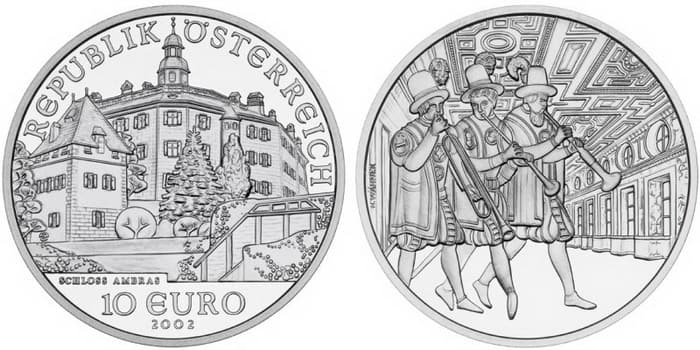
60 years of the Second Republic (5.11.2005):
- Weight : 17.3 g
- Diameter: 32 mm
- Obverse: Greek goddess of wisdom Athena-Pallada in front of the Viennese Parliament building, symbolizing the Republic of Austria; 9 coats of arms of the federal states around it; inscription «REPUBLIK ÖSTERREICH» at the top; denomination and year of minting at the bottom.
- Reverse: parliament building in Vienna; protesting crowd and a symbolic chain with a torn link; inscription «60 Jahre Zweite Republik» at the bottom.
- Circulation: 230,000
Austrian 10 Euro 2005 silver coins in GoldAdvert catalog.
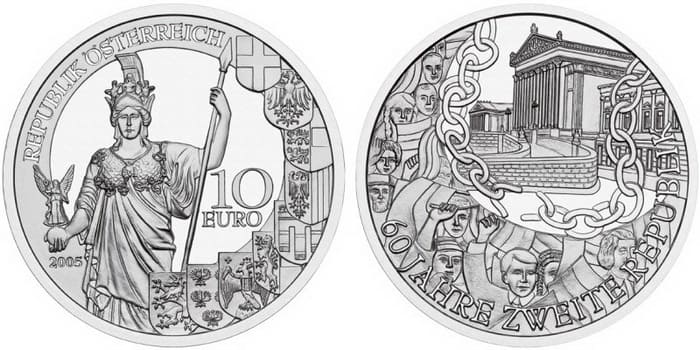
Austria and her people (famous abbeys of Austria)
Abbey of Nonberg (4.5.2006):
- Weight: 17.3 g
- Diameter: 32 mm
- Obverse: The Benedictine monastery “Nonberg” with the mountain and the castle “Hohensalzburg” on the background; inscription «Benediktinerinnenabtei Nonnberg» at the top; denomination, inscription «REPUBLIK ÖSTERREICH» and year of minting at the bottom.
- Reverse: monastery interior with a cast of St. Rupert’s niece; statue of the first abbess on the foreground and an inscription «Erentrudis» next to it.
- Circulation: 230,000
Austrian 10 Euro 2006 silver coins in GoldAdvert catalog.
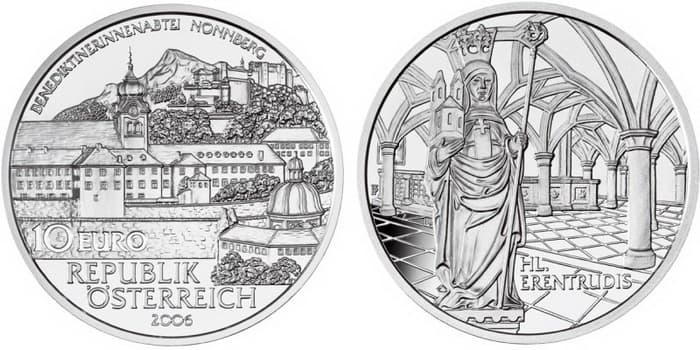
Myths and legends of Austria
Basilisk in Vienna (4.15.2009):
- Weight: 16 g
- Diameter: 32 mm
- Obverse: Schenlatern alley in Vienna; mountain and Fortress Hohensalzburg on the background; inscription «Schönlaterngasse» at the top; denomination, inscription «REPUBLIK ÖSTERREICH» and year of minting at the very bottom.
- Reverse: basilisk sitting at the bottom of a well, looking in the mirror; baker’s student hiding behind the mirror; inscription «Der basilisk» at the bottom.
- Circulation: 200,000
Austrian 10 Euro 2009 silver coins in GoldAdvert catalog.
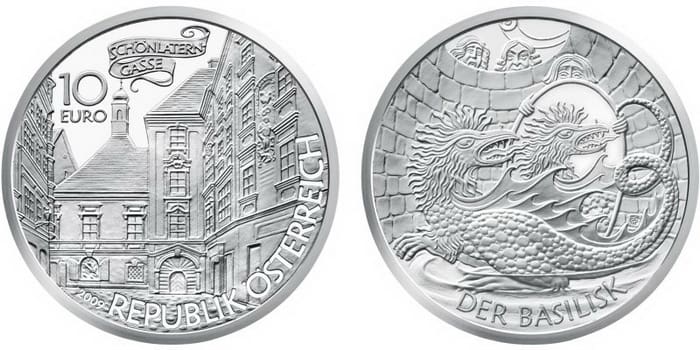
Federal lands of Austria
Styria (4.25.2012):
- Weight: 17.3 g
- Diameter: 32 mm
- Obverse: famous buildings of the city of Graz: the clock tower, Eggenberg Palace, Town Hall, the church tower and mausoleum; inscription «REPUBLIK ÖSTERREICH» at the top; the name of city «Graz» a little below; denomination and year of minting at the bottom.
- Reverse: Nature of Styria; inscription «Steiermark» to the left.
- Circulation: 130,000
Austrian 10 Euro 2012 silver coins in GoldAdvert catalog.
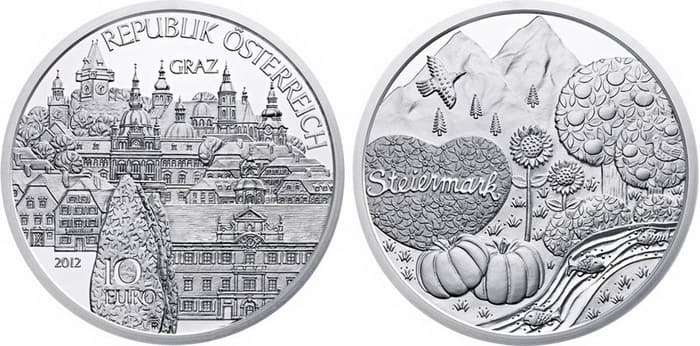
A nominal value of 20 euro (fineness of 900)
The way through the ages (Austria)
Renaissance (6.12.2002):
- Weight: 20 g
- Diameter: 34 mm
- Obverse: “Swiss Gate” of the Vienna Palace Hofburg, which were made in the Renaissance style ordered by Ferdinand I; two soldiers guarding the gate symbolizing the siege of Vienna in 1529.
- Reverse: portrait of Ferdinand I; empire coat of arms to the left and «1503-1564» to the right; inscription «Ferdinand I» at the top.
- Circulation: 50,000
Austrian 20 Euro 2002 silver coins in GoldAdvert catalog.
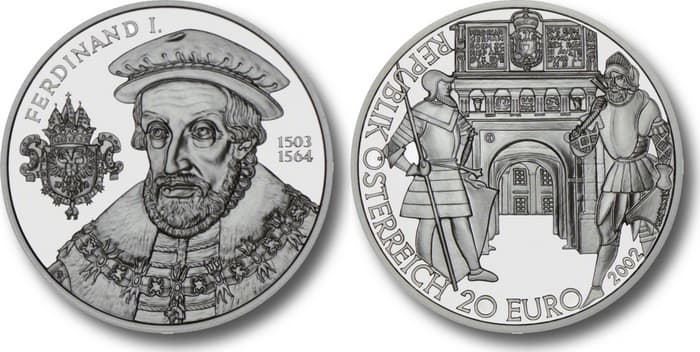
Austria on High Seas
The cruiser “St. George” (9.14.2005):
- Weight: 20 g
- Diameter: 34 mm
- Obverse: cruiser “St. George”, sent to New York on May 17, 1907 passing the Statue of Liberty; PANZER KREUZER S.M.S. ST. GEORG» at the top; inscription «REPUBLIK ÖSTERREICH», denomination and year of minting at the bottom
- Reverse: marine arsenal of the Pula base; “St. George” in the dock; steamship on the foreground; inscription «Seearsenalpola» at the top.
- Circulation: 50,000
Austrian 20 Euro 2005 silver coins in GoldAdvert catalog.
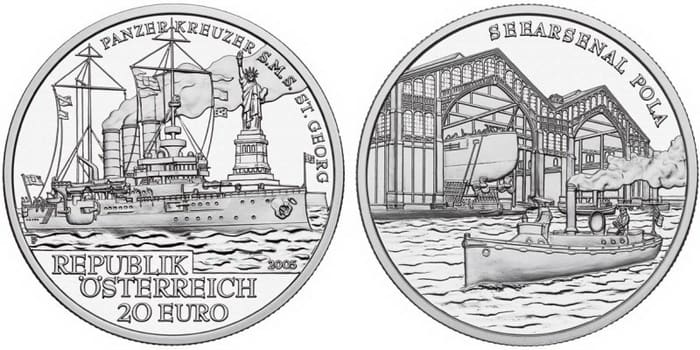
Austrian Railways
Electric railway (6.17.2009):
- Weight: 18 g
- Diameter: 34 mm
- Obverse: high-speed train “Railjet”, which was put into operation in 2008-2009; denomination at the top; inscription «REPUBLIK ÖSTERREICH», year of minting at the bottom.
- Reverse: moment of cargo transportation and general view of sorting stations; 1063 class electric locomotive on the foreground; inscription «VERSCHUBLOK 1063» at the very bottom.
- Circulation: 50,000
Austrian 20 Euro 2009 silver coins in GoldAdvert catalog.

Rome on Danube
Lauriacum (4.11.2012):
- Weight: 20 g
- Diameter: 34 mm
- Obverse: portrait of the emperor Grazian; inscription «KAISER GRATIANUS»; Saint Florian Lorchsky, the patron saint of the province of Upper Austria; inscription «HL. FLORIAN»; inscription «REPUBLIK ÖSTERREICH», denomination and the year of minting.
- Reverse: construction of bridge and road by Romans; the inscription «LAURIACUM».
- Circulation: 50,000.
Austrian 20 Euro 2012 silver coins in GoldAdvert catalog.

Living prehistory
Triassic (4.17.2013):
- Weight: 20 g
- Diameter: 34 mm
- Obverse: ammonites; inscription «REPUBLIK ÖSTERREICH»; denomination and year of minting; historical period “Trias” at the very bottom.
- Reverse: ichthyosaur devouring the ammonite on the foreground of the sea depths; nothosaur.
- Circulation: 50,000
Austrian 20 Euro 2013 silver coins in GoldAdvert catalog.

Gold euros series
A nominal value of 50 euro (fineness of 986)
2,000 years of Christianity
The Catholic Order of St. Benedict (3.13.2002):
- Weight: 10.14g
- Diameter: 22 mm
- Obverse: St. Benedict with his sister; the holy Scholasticism as a dove; inscription «REPUBLIK ÖSTERREICH»; historical denomination.
- Reverse: monk working on his manuscript.
- Circulation: 50,000
Austrian 50 Euro 2002 gold coins in GoldAdvert catalog.

Great composers
Josef Haydn (3.20.2004):
- Weight: 10.14 g
- Diameter: 22 mm
- Obverse: Esterházy castle, which Haydn lived in; musical staff above the castle; inscription «REPUBLIK ÖSTERREICH» and denomination at the bottom; «Schloss Esterhazy» at the top; year of minting under the image of the castle.
- Reverse: portrait of Haydn; his autograph and years of his life; inscription «Joseph Haydn».
- Circulation: 50,000
Austrian 50 Euro 2004 gold coins in GoldAdvert catalog.
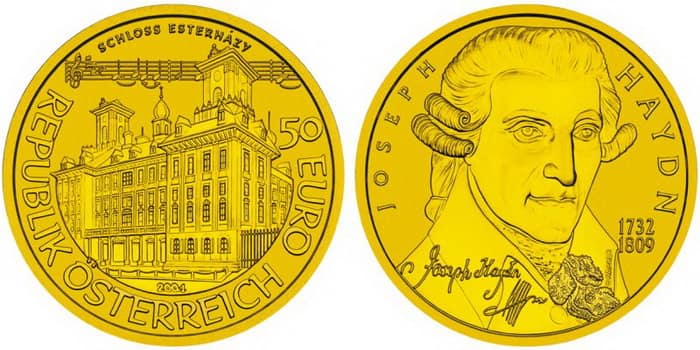
Famous doctors of Austria
Ignaz Philip Semmelweis (1.30.2008):
- Weight: 10.14 g
- Diameter: 22 mm
- Obverse: portrait of a doctor Ignaz Philip Semmelweis; denomination, year of minting and the image of the Rod of Asclepius (the symbol of healing) on the right; years of his life to the left; inscription «REPUBLIK ÖSTERREICH» at the bottom.
- Reverse: facade of the old Viennese hospital, where Semmelweis worked; two doctors washing their hands before examining; inscription «Allgemeines Krankenhaus Wein» at the bottom.
- Circulation: 50,000
Austrian 50 Euro 2008 gold coins in GoldAdvert catalog.
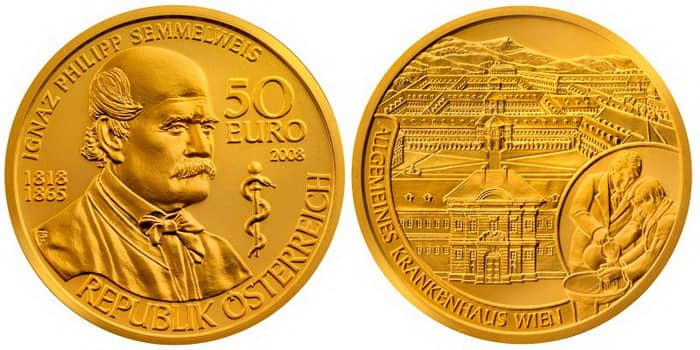
Klimt and his women
Portrait of Adele Bloch-Bauer (1.25.2012):
- Weight: 10.14 g
- Diameter: 22 mm
- Obverse: portrait of Gustav Klimt; inscription «REPUBLIK ÖSTERREICH»; denomination and year of minting at the bottom.
- Reverse: fragment of the portrait of Adele Bloch-Bauer.
- Circulation: 30,000
Austrian 50 Euro 2012 gold coins in GoldAdvert catalog.

A nominal value of 100 euro (fineness of 986)
Art treasures of Austria
Sculpture (11.13.2002):
- Weight: 16.2g
- Diameter: 30 mm
- Obverse: portrait of the Baroque sculptor Georg Rafael Donner; Lower Belvedere palace on the background; inscription «REPUBLIK ÖSTERREICH» and denomination at the top; his signature at the bottom left and year of minting at the bottom right.
- Reverse: fountain “Provendentia Brunnen” in Vienna created by the same sculptor; inscription «Providentia Brunnen» at the top.
- Circulation: 30,000
Austrian 100 Euro 2002 gold coins in GoldAdvert catalog.

Viennese Art Nouveau
Vienna Secession (11.10.2004):
- Weight: 16.22 g
- Diameter: 30 mm
- Obverse: facade of the Vienna exhibition hall “Secession”; inscription «REPUBLIK ÖSTERREICH» at the top; denomination and year of the minting at the bottom.
- Reverse: fragment of one of the paintings of Gustav Klimt in the gallery “Beethoven Frieze”; inscription «Beeyhoven Fries» at the bottom left.
- Circulation: 30,000
Austrian 100 Euro 2004 gold coins in GoldAdvert catalog.
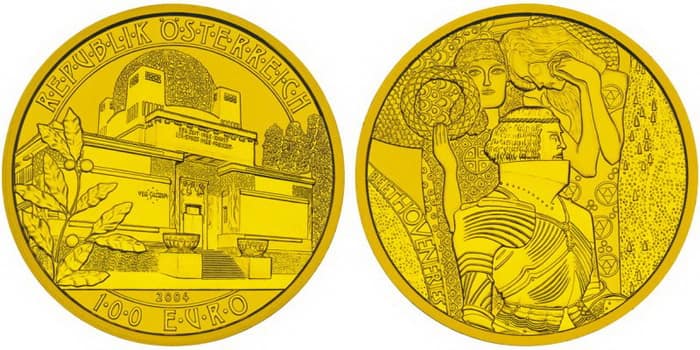
The Crowns of the House of Habsburg
The crown of the Austrian Empire (11.14.2012):
- Weight: 16.227g
- Diameter: 30 mm
- Obverse: Austrian imperial crown; inscription «REPUBLIK ÖSTERREICH» at the top; denomination and year of minting indicated horizontally on both sides of the crown; inscription «DIE ÖSTERREICHISCHE KAISERKRONE» at the bottom; dotted line decoration.
- Reverse: Franz Joseph I holding a scepter in his right hand; crown to his right; imperial coat of arms in the background to the right; inscription FRANZ JOSEPH I.»;dotted line decoration.
- Circulation: 30,000
Austrian 100 Euro 2012 gold coins in GoldAdvert catalog.
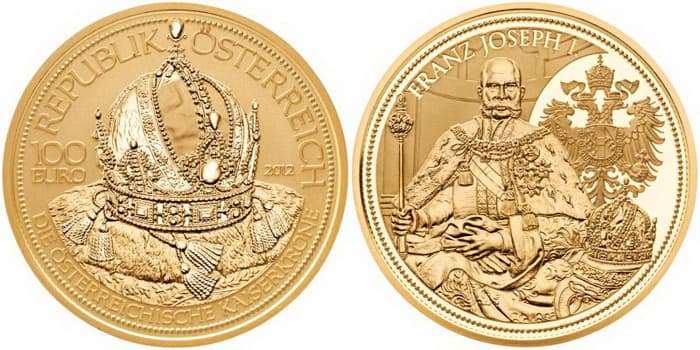
European numismatic program (themes of the year)
A nominal value of 5 euro (silver 800) 2004-2009
European Union Enlargement (1.28.2004):
- Weight: 10g
- Diameter: 28.5 mm
- Obverse: denomination surrounded by 9 coats of arms of Austrian federal lands; inscription «REPUBLIK ÖSTERREICH» and denomination;edge in the form of enneagon.
- Reverse: schematic map of Europe; inscription «EU-ERWEITERUNG 2004»; list of the countries that have become new members of the European Union; edge in the form of enneagon.
- Circulation: 400,000
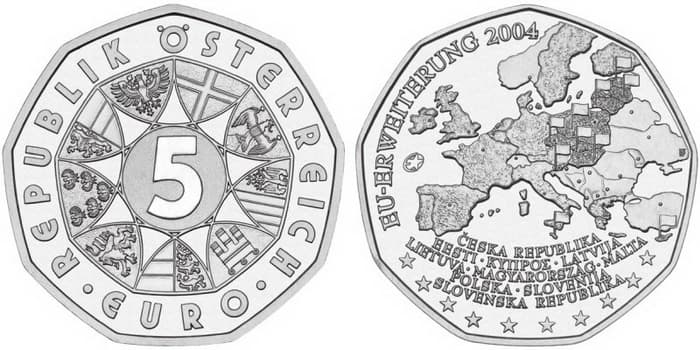
A nominal value of 20 euro (silver 900) 2011-2013
European artists
Egon Schiele (3.14.2012):
- Weight: 20 g
- Diameter: 34 mm
- Obverse: portrait of Egon Schiele; fragment of the picture “Crouching”on the background; denomination «20 EURO»; inscription «REPUBLIK ÖSTERREICH»; year of minting «2012» in the center.
- Reverse: Egon Schille’s painting “Portrait of Wally”
- Circulation: 50,000
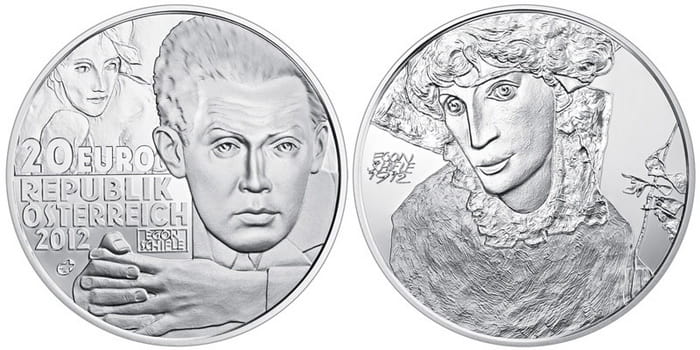
Commemorative silver and gold coins
A nominal value of 5 euro (silver 800)
250 years to Vienna Zoo (5.8.2002):
- Weight: 10 g
- Diameter: 28.5 mm
- Obverse: denomination surrounded by 9 coats of arms of Austrian federal lands; inscription «REPUBLIK ÖSTERREICH» and denomination; edge in the form of enneagon.
- Reverse: animals on the foreground of the pavilion of the emperor of the Vienna Zoo; year of the foundation and the anniversary year; inscription «250 JAHRE TIERGARTEN SCHÖNBRUNN»; edge in the form of enneagon.
- Circulation: 600,000
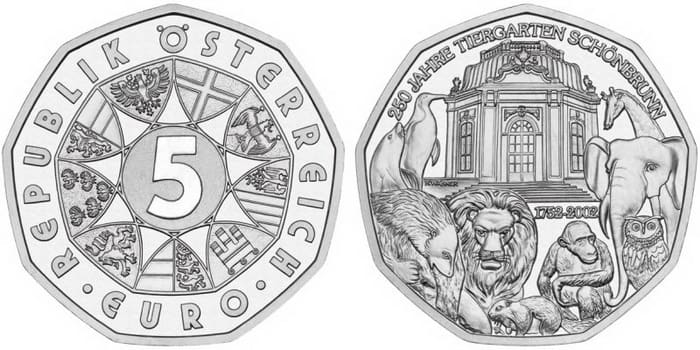
A nominal value of 25 euro of silver and niobium (fineness of Ag 900 / Nb 998)
Artificial lighting (3.12.2008):
- Weight: 16.5 g
- Diameter: 34 mm
- Obverse: moment of a real event when the square in front of the City Hall in Vienna had street lamps; inscription «REPUBLIK ÖSTERREICH»; denomination and year of minting at the bottom.
- Reverse: portrait of Welbach, sun and different kinds of lamps; inscription «NEON» at the top.
- Circulation: 65,000
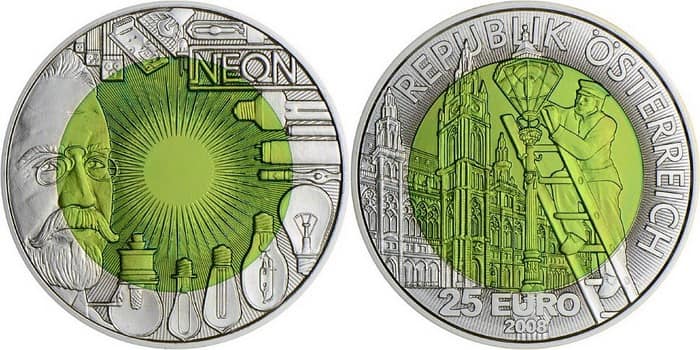
A nominal value of 50 euro of gold (fineness of 986)
200th Anniversary of the Museum in Graz (1.26.2011):
- Weight: 10 g
- Diameter: 22 mm
- Obverse: facade of the «Kunsthaus» exhibition center; denomination at the top; an inscription «REPUBLIK ÖSTERREICH» at the bottom; name of the center «Kunsthaus» and year of minting in the center.
- Reverse: knight’s armor in the museum; inscription «LANDESZEUCHAUS GRAZ» at the bottom left.
- Circulation: 50,000
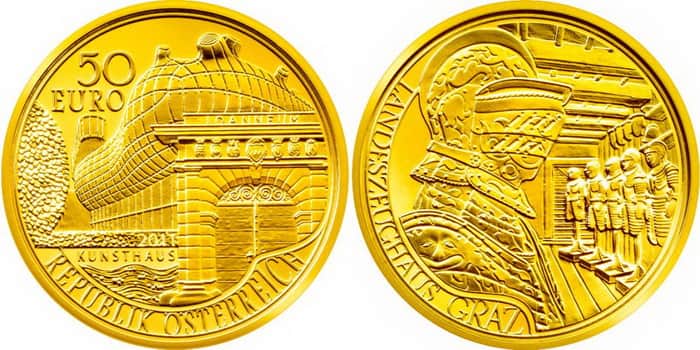
Why were such coins and series created
Commemorative and investment coins are primarily an interest to numismatists, but there are some differences between them. For example, the denominations of the “Philharmoniker” coin made from gold and silver, are investment ones, but they can serve as an official means of payment in Austria , where the euro has been in circulation since 2002. Commemorative coins are attractive to collectors only, given the small amount of their distribution.

Each commemorative coin is dedicated to an event, bright moments in the history and culture of the country. In addition to individual commemorative coins, there are series devoted to one theme and are issued year after year. In 2004, the European numismatic program was adopted, which defines the general idea of issuing coins for a year for all EU countries. The number of countries participating in this program varies from year to year, but Austria regularly issues 5 and 20 euro denominations in silver fineness of 800 and 900.
Design development
All coins represented in this article were created by designers and artists of the Austrian Mint:
- Thomas Pesendorfer;
- Helmut Andeclinger;
- Andreas Zanaska;
- Herbert Weiner.
Thomas Pesendorfer, chief engraver of the Austrian Mint, personally developed the design of the “Vienna Philharmonic” coins. This work became the most iconic in his career.
What are the denominations of silver and gold coins
Since 2002, Austria has been minting silver and gold collectible coins in such denominations:
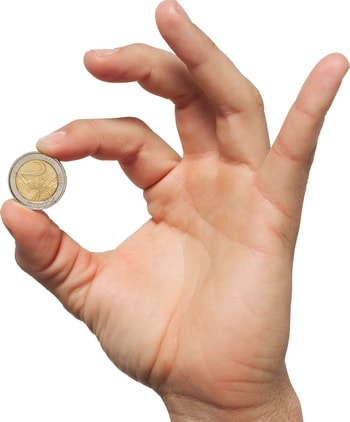
- silver : 5 , 10, 20 , 25 euro ;
- gold: 50, 100 euro.
Commemorative coins with a 25 euro denomination are made of two kinds of metal – silver, and niobium.
Besides, an investment coin “Vienna Philharmonic” was issued in following denominations:
- silver: 1,5 euro;
- gold: 10, 25, 50, 100 euro.
In addition, the limited series of “Philharmoniker” was issued in 2 (2009), 4 (2015), 2000 (2009) and 100 000 (2004) euro denominations. Their specifications are:
- 10 Austrian euro : weight 3.121 g, diameter 16 mm, thickness 1.2 mm.
- 25 Austrian euro : weight 7.776 g, diameter 22 mm, thickness 1.2 mm.
- 50 Austrian euro : weight 15.552 g, diameter 28 mm, thickness1.6 mm.
- 100 Austrian euro : weight 31.103 g, diameter 37 mm, thickness 2.0 mm.
Interesting facts
- Austria was one of the first countries to mint bimetallic coins from silver and colored niobium of 25 euro face value.
- The “River Gate” coin from the “Vienna Modern” series was issued in 2006 as a way to honor the 100th anniversary of their discovery.
- By the end of the XIX century, the dualistic system of government in Austria-Hungary was replaced by a constitutional system with the parliament, and the “Bill of Rights” had been already signed in 1867, which resulted in the same suffrage for all men in 1907.
- The Basilica of Mariazell, depicted on the commemorative silver coin of 5 euro (2007), is one of the main places of pilgrimage in Austria.
- Theodore Billroth, depicted on a gold coin of 50 euro (2009), studied and practiced medicine from 1829 to 1894, developing the basics of safe surgeries by applying antiseptics.
- In 2009, 400 years passed since Galileo invented the telescope, which led to the issuance of the commemorative coin “World Year of Astronomy”, made of silver and niobium.
Comments
No commens yet.